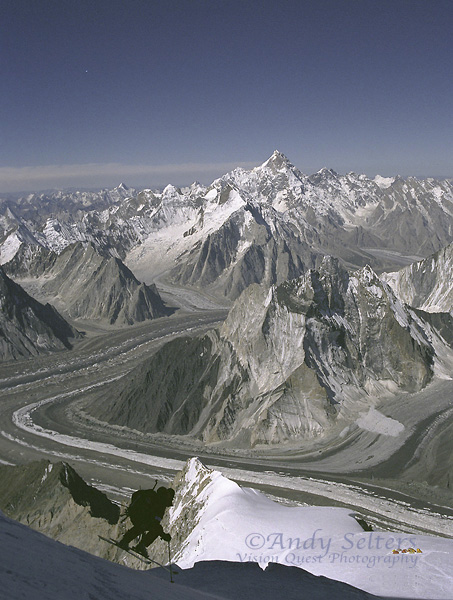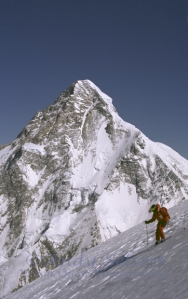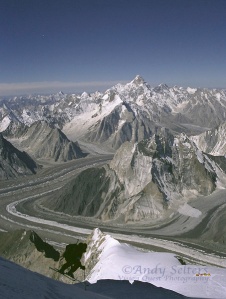I finally got to see the film The Summit, thanks to my friend Darcy Ellis! The movie did an impressive job of realistically re-creating unfilmed parts of the 2008 tragedies on K2 with re-enactments from the Alps, including generating computerized settings that look surprisingly like K2. With minor exceptions the story was accurately and vividly portrayed. However, why did the filmmaker throw in Walter Bonatti interviews and footage from 1954? Jumping back and forth to an over-argued controversy was distracting. I was also disappointed not to see more from the Korean team perspective.
I’m seen in a couple of anonymous cameo appearances. One is when several of us are carrying Wilco von Rooijen to his rescue helicopter. The other is near the very end when I am talking with Pemba Gyalje; he’s telling me how Marco had at first aggressively repulsed Pemba’s efforts to help him, basically fighting Pemba off from saving his life. As I heard Pemba’s tale I recognized that Marco was in a medical condition we call “combative.” Irrational aggression happens when our brain is suffering or especially physically pressured, as with high altitude cerebral edema. I respond (unknowingly on camera) by saying that Marco at that point was “a head case.” Everyone since has been pulling for Marco to tell what exactly happened with Gerard McDonnell (especially Gerard’s family of course). Marco really tried, he loved Gerard. What someone caught on film was Pemba telling me that Marco was in pretty bad shape up there, lucky enough to get down much less put together all the details of who did what and when and why. I was really moved to see Gerard’s family and girlfriend tell their perspectives; it’s gotta hurt bad.
My experience at nearly 8000 meters those same days on nearby Broad Peak was enough to tell me it’s really tough that high. Even if “the climbing is easy” we all operate up there on a tenuous thread that needs to be carefully planned for. You have to have your extreme on. Ounces feel like kilograms, steps seem like miles, and all things need to go right. And you need partners, all of us at some point anyway. I realize now that I can share some additional lessons from that season.
On Broad Peak summit day I ended up being the strongest member of our team, the only one with a chance for the top. As probably 30 of us on Broad Peak settled in for a short night at over 23,000 feet a wicked wind came up. Everyone for hours feared their tents were about to be ripped away, nobody slept. On K2 that night a Serbian climber named Hoselito was indeed sheared off his perch, and as he dangled from an anchor Pemba answered his cries and saved him. No one would consider going for the top in that wind. Then suddenly at about 2:30am it stopped. It was like being transported; in one minute it went from scary tempest to a starry, calm night, the usual 25 below or so. Everyone on Broad Peak booted up and raced off, despite the later-than-planned start and no sleep. My partner Dave Watson took off I believe without drinking or eating anything. I decided that on one of the half-dozen toughest endurance days of my life I needed at least a basic ration of unwarm tea and a cup of grape-nuts in milk. I was one of the last to leave camp, but I ended up somehow passing people.
I caught up to and teamed with Oh Eun-sun, one of two Korean women then aiming to be the first woman to climb all 8000m peaks. Others who were real pros at 8000 meters, including Daniel Nardi and Veikka Gustafsson, were ahead in a real league of their own, with things going well for them but still in for a very long day. As a beautiful day dawned I kept telling myself I wouldn’t push to my limits, at 50 years old I was “just” a photographer, I needed to catch up to Dave and get shots of him skiing down, and I knew we both needed to save something for our real show, K2 the following week. Oh and I traded off breaking trail for each other in breakable crust 8 or 10 inches deep. I enjoyed her company. I noticed how she carried nothing but a small camcorder clipped to her harness; no water, no food, no extra anything, no pack at all. I had a liter thermos and about 8 ounces of some kind of snack, plus spare mittens. Behind us were a team of several Spaniards. Then the crust hardened a bit, and Oh, who probably weighs 100 pounds or less, stopped breaking through. She started walking on the crust like it was a sidewalk and cruised on ahead, while I kept punching through with every gasping step. The Spaniards slowly caught up to me in my lead toil, but they said they didn’t feel strong enough to take over breaking trail. They took a rest and I kept going.
I made it up to the bergschrund as I saw Oh climb up a convenient snow ramp leading over it and onto the easy final slope to the col. To my right was a guy coming up, he carried skis. I realized it was Dave. In the dark two separate routes had developed, and somehow I had gotten ahead of him. He came over and said he felt awful, he had puked a couple of times, he’d rested for awhile at the very high camp that the Iranian team had put up, and he was turning around. Dave has climbed Everest twice, and throughout the trip he had been the strongest among us. When he says he’s going down, it’s because he has to.
I thought about what I should do for about one minute. I was there especially to get pictures of Dave skiing, something very few people have done on an 8000er. I really wanted to get to the col at least to see the undoubtedly amazing other side of the Karakoram. But Dave was not looking too good. The Spaniards arrived and a couple of them were surprised and perhaps a little disappointed that I was also turning around, even though I was still moving relatively strong. There’s a long way to go on Broad Peak’s summit ridge. My instinct was to stick with my partner, and that’s what I did.
I poured Dave some tea from my thermos. He stepped into his skis, I got out my camera. He started skiing and I started marching down, sort of keeping up. He would do a few turns in the crappy crust and variable powder and then stop and gasp. A couple of times he stopped and dry-puked. He’s an amazing skier. I got some good shots, with K2 behind, Nanga Parbat way off to the southwest. Within an hour we’d descended about 1500 feet and he started feeling a lot better. He even pulled off a series of jump turns in the crust. He got down to our tents 15 minutes ahead of me, and I was glad marginally thicker air was already doing him better.
About that time I fell knee-deep into a crevasse. I could feel the space beneath my dangling feet, and I grasped over to clutch at something solid. This was dangerous. I was right on the route everyone had walked on, and there were supposedly no crevasses up there, but in that drought year I found one. I felt extra imperiled because I knew that even though there were some 30-odd internationally experienced climbers in the vicinity on that summit day, none had any rope. The nearest length of cord was thousands of feet below; if I or anyone else had fallen in deeper there could have been no rescue. That’s how hard you work up there, nobody wants to carry a single ounce. It took five minutes but I swam out, the crust supported me.
Dave and I packed up Camp 3 with a good 40 pounds each. He skied down and got to Camp 2 a good hour ahead of me. The next day we loaded up everything from Camp 2 as well. With Chuck Boyd having gone down some days before not feeling well, and extreme skier extraordinaire Dan McCann having already flown home after surviving a horrendous fall, Dave and I had to carry absurd loads, at least 90 pounds each. Negotiating over clifflets and icy slopes even fixed with rope was tough while tottering under that kind of burden. At one point on glazed-over rock Dave slipped and hung from his ascender. He called for help, and it was all we could both do to get him back up and unweighted from the rope so he could continue down. About 8 of us waited overnight at Camp 1, as per Veikka’s radio recommendations, because the afternoon rockfall was horrendous. The next dawn we made it down through the trashy limestone and melt cascades and rockfall and tattered ropes that made up Broad Peak’s pitiful lower slopes in that season after an almost snowless winter and spring. When we got to the bottom Dave turned on the radio and heard the awful news unfolding on K2.
With each 8000 meter peak season all sorts of tragic and heroic stories come through the wires. My one-season experience with how people operate up there prompts a question: What if I had decided to keep going up on Broad Peak? Several people have asked me why I didn’t. Perhaps that’s the norm. I don’t think Dave would have thought the worse of me, and had our situations been reversed, he probably would have kept going up. He was at that younger stage of life. In retrospect we can see that he had played the odds ok, he was quite capable to get himself down. Well, regardless of the odds I wouldn’t have felt good about leaving him in an uncertain condition. Second, I wouldn’t have gotten the photos, my primary role and avenue to success on the trip. Third is my main point here, to speak to how climbers—and people in general—do and don’t work together. If I’d continued up I wouldn’t have felt good in an extreme situation with no partner, and in proximity to a dozen or more acquaintances any of whom I might have to count on, or who might have to count on me. That struck me as pretty strung out. Basically I hadn’t prepared to solo Broad Peak, and I’ve never liked the idea of tossing my lots to work around people in extreme situations whose trust I have no basis to share.
Follow through with the possibility though: if I did continue up, and everything had gone well to the top, then there would be the matter of getting down and getting all our gear down. I had no radio, Dave carried our shared unit so we could talk to basecamp. We would have had no way to coordinate reuniting for descent, no way to know how the other was doing, no way to figure out how to divvie the loads, no way to help each other on the long descent. At the very least, the potential for acrimony would have been high, with me stumbling beyond exhaustion and utterly spent from the summit, Dave hopefully ok but having to guess what to leave for me and whether to wait and for how long, each of us on our own but still counting on each other.
And that describes well a dysfunction with how so much of modern life goes on now, notably on 8000 meter peaks but in most every sphere. People go into endeavors grand and small aspiring to be individuals and practically wanting little to do with each other, all the while being fairly or utterly dependent on everyone else in that sphere. We want freedom and we want support and we push the envelope in both directions at the same time. I was surprised to read in the great Ed Viesturs’s autobiography that even he steered his plans toward a thankful use of fixed ropes that other parties had strung up. A crack French team preparing to do the west face of K2 alpine style that 2008 season came over to acclimatize with all of us on Broad Peak, and they naturally made liberal use of the fixed ropes that we’d strung. Reinhold Messner is always described as a lone superman, but on many peaks and especially on K2 he had partners and jugged fixed ropes like everyone else. It’s just super hard to both acclimatize and climb without sharing the logistical challenge, much less the emotional challenge. Honest sharing is fine, I’ll leave it to others and other times to declare standards of 8000 meter ascent legitimacy. But when there’s stress and fungible muddiness in partnering and everyone maneuvering for private commercial glory it creates shaky partnerships and unreliable dependencies—this is what sets the stage for hard and bitter times, and sometimes disaster. Press reports and sponsorships and our culture all slant that way. Whole expedition tales are summarized in grossly simple lists of summiters and when and how many more to go. That publicity structure effectively focuses the endeavors, and climbers force themselves into half-trusted alliances they might hope to leave any step of the way.
To compare though, like any American I couldn’t find fulfillment within the Russian or Korean expedition model, where a big team of comrades operates under a commander issuing assignments and coordinates.
Natural partnerships can remain simple even in extreme situations, and we all know how they work when we climb in our local mountains. The four Norwegians on K2 had it going seamlessly, as did Veikka and his two partners. Certainly they were commercially motivated and supported teams. But first and foremost they were partners, they knew and trusted each other and stuck with each other from start to finish.



